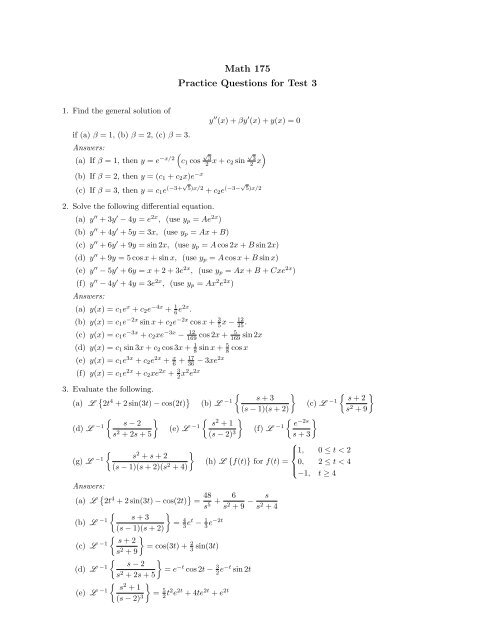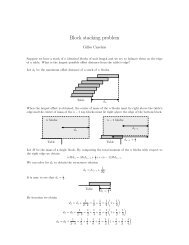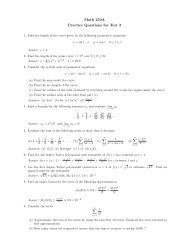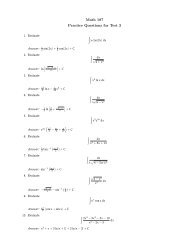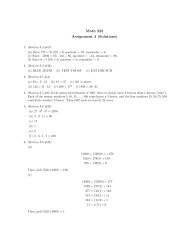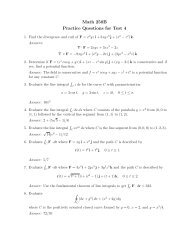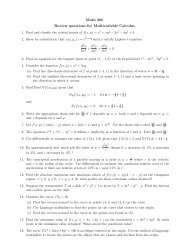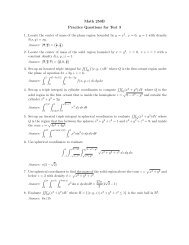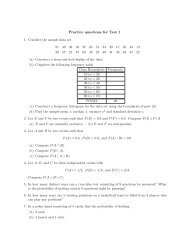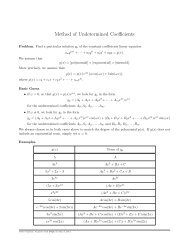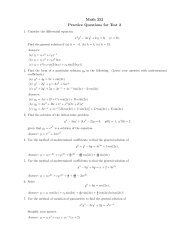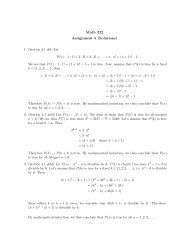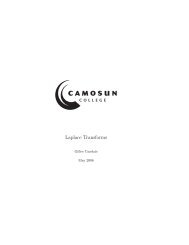Math 175 Practice Questions for Test 3
Math 175 Practice Questions for Test 3
Math 175 Practice Questions for Test 3
Create successful ePaper yourself
Turn your PDF publications into a flip-book with our unique Google optimized e-Paper software.
<strong>Math</strong> <strong>175</strong><br />
<strong>Practice</strong> <strong>Questions</strong> <strong>for</strong> <strong>Test</strong> 3<br />
1. Find the general solution of<br />
if (a) β = 1, (b) β = 2, (c) β = 3.<br />
y ′′ (x) + βy ′ (x) + y(x) = 0<br />
Answers:<br />
(a) If β = 1, then y = e<br />
(c −x/2 1 cos √ 3<br />
2 x + c 2 sin √ )<br />
3<br />
2 x<br />
(b) If β = 2, then y = (c 1 + c 2 x)e −x<br />
(c) If β = 3, then y = c 1 e (−3+√ 5)x/2 + c 2 e (−3−√ 5)x/2<br />
2. Solve the following differential equation.<br />
(a) y ′′ + 3y ′ − 4y = e 2x , (use y p = Ae 2x )<br />
(b) y ′′ + 4y ′ + 5y = 3x, (use y p = Ax + B)<br />
(c) y ′′ + 6y ′ + 9y = sin 2x, (use y p = A cos 2x + B sin 2x)<br />
(d) y ′′ + 9y = 5 cos x + sin x, (use y p = A cos x + B sin x)<br />
(e) y ′′ − 5y ′ + 6y = x + 2 + 3e 2x , (use y p = Ax + B + Cxe 2x )<br />
(f) y ′′ − 4y ′ + 4y = 3e 2x , (use y p = Ax 2 e 2x )<br />
Answers:<br />
(a) y(x) = c 1 e x + c 2 e −4x + 1 6 e2x .<br />
(b) y(x) = c 1 e −2x sin x + c 2 e −2x cos x + 3 5 x − 12<br />
25 .<br />
(c) y(x) = c 1 e −3x + c 2 xe −3x − 12<br />
5<br />
169<br />
cos 2x +<br />
169<br />
sin 2x<br />
(d) y(x) = c 1 sin 3x + c 2 cos 3x + 1 8 sin x + 5 8 cos x<br />
(e) y(x) = c 1 e 3x + c 2 e 2x + x 6 + 17<br />
36 − 3xe2x<br />
(f) y(x) = c 1 e 2x + c 2 xe 2x + 3 2 x2 e 2x<br />
3. Evaluate the following.<br />
(a) L { 2t 4 + 2 sin(3t) − cos(2t) } (b) L −1 {<br />
{ } s − 2<br />
(d) L −1 s 2 + 2s + 5<br />
{<br />
(g) L −1 s 2 }<br />
+ s + 2<br />
(s − 1)(s + 2)(s 2 + 4)<br />
}<br />
{ }<br />
s + 3<br />
s + 2<br />
(c) L −1<br />
(s − 1)(s + 2)<br />
s 2 + 9<br />
{ } e<br />
(f) L −1 −2s<br />
s + 3<br />
⎧<br />
⎪⎨ 1, 0 ≤ t < 2<br />
(h) L {f(t)} <strong>for</strong> f(t) = 0, 2 ≤ t < 4<br />
⎪⎩<br />
−1, t ≥ 4<br />
{ s<br />
(e) L −1 2 }<br />
+ 1<br />
(s − 2) 3<br />
Answers:<br />
(a) L { 2t 4 + 2 sin(3t) − cos(2t) } = 48<br />
s 5 + 6<br />
s 2 + 9 − s<br />
s 2 + 4<br />
{<br />
}<br />
(b) L −1 s + 3<br />
= 4<br />
(s − 1)(s + 2)<br />
3 et − 1 3 e−2t<br />
{ } s + 2<br />
(c) L −1 s 2 = cos(3t) + 2<br />
+ 9<br />
3 sin(3t)<br />
(d) L −1 { s − 2<br />
s 2 + 2s + 5<br />
}<br />
= e −t cos 2t − 3 2 e−t sin 2t<br />
(e) L −1 { s 2 + 1<br />
(s − 2) 3 }<br />
= 5 2 t2 e 2t + 4te 2t + e 2t
<strong>Math</strong> <strong>175</strong> <strong>Practice</strong> <strong>Questions</strong> <strong>for</strong> <strong>Test</strong> 3 Page 2 of 2<br />
{ } e<br />
(f) L −1 −2s<br />
= e −3(t−2) U(t − 2)<br />
s + 3<br />
{<br />
(g) L −1 s 2 }<br />
+ s + 2<br />
(s − 1)(s + 2)(s 2 = 4<br />
+ 4)<br />
15 et − 1 6 e−2t − 1<br />
10 cos 2t + 1 5<br />
sin 2t<br />
(h) L {f(t)} = 1 s − e−2s<br />
s<br />
− e−4s<br />
s<br />
4. Use Laplace trans<strong>for</strong>m to solve the initial value problems.<br />
(a) y ′′ (t) − 2y ′ (t) + 2y(t) = e t , y(0) = 2, y ′ (0) = 0.<br />
(b) y ′′ (t) − 4y ′ (t) = 3e −t , y(0) = 1, y ′ (0) = −1.<br />
(c) y ′′ (t) + 2y ′ (t) + 5y(t) = 10, y(0) = 0, y ′ (0) = 0.<br />
(d) y ′′ (t) − y ′ (t) − 2y(t) = cos(2t), y(0) = 1, y ′ (0) = −2.<br />
(e) y ′′ (t) + y(t) = sin(2t), y(0) = 1, y ′ (0) = 0.<br />
(f) y ′′ (t) + 9y(t) = cos(3t), y(0) = 1, y ′ (0) = 2.<br />
(g) y ′ (t) + 2y(t) = f(t), y(0) = 3, where f(t) =<br />
Answers:<br />
(a) y(t) = e t + e t cos t − 2e t sin t<br />
(b) y(t) = 1 2 + 3 5 e−t − 1<br />
10 e4t<br />
(c) y(t) = 2 − 2e −t cos(2t) − e −t sin(2t)<br />
(d) y(t) = 7 5 e−t − 1 4 e2t − 3<br />
20 cos(2t) − 1<br />
20 sin(2t)<br />
(e) y(t) = − 1 3 sin(2t) + cos t + 2 3 sin t<br />
(f) y(t) = 2 3 sin(3t) + cos(3t) + 1 6 t sin(3t)<br />
(g) y(t) = 1 2 + ( 5<br />
2 e−2t − ) 1 2 1 − e<br />
−2(t−1)<br />
U(t − 1)<br />
{<br />
1, 0 ≤ t ≤ 1<br />
0, t ≥ 1<br />
5. The differential equation <strong>for</strong> the current i(t) in an LR series circuit is<br />
L di + Ri(t) = V (t).<br />
dt<br />
If the inductance and resistance are respectively L = 1 H, R = 10 Ω and<br />
{<br />
1, 0 ≤ t < 2<br />
V (t) =<br />
0, t ≥ 2.<br />
Find the current i(t) if i(0) = 0.<br />
Answer: The current is<br />
or<br />
i(t) = 1 10 − 1<br />
10 e−10t − 1 1<br />
U(t − 2) + U(t − 2)e−10(t−2)<br />
10 10<br />
i(t) =<br />
{<br />
1<br />
10 (1 − e−10t ), 0 ≤ t < 2<br />
1<br />
10 (e−10(t−2) − e −10t ), t ≥ 2<br />
6. Find the current in an LR circuit if L = 2 H, R = 4 Ω and V (t) = 5e −t volts. Assume i(0) = 0.<br />
Answer: i(t) = 5 2 e−t − 5 2 e−2t<br />
7. Find the charge on the capacitor q(t) and the current i(t) in an LRC circuit if L = 5 3<br />
H, R = 10 Ω,<br />
C = 1<br />
30<br />
F and V = 300 V if q(0) = 0 and i(0) = 0.<br />
Answer: The charge and current are<br />
q(t) = 10 − 10e −3t (cos 3t + sin 3t) and i(t) = 60e −3t sin 3t.


